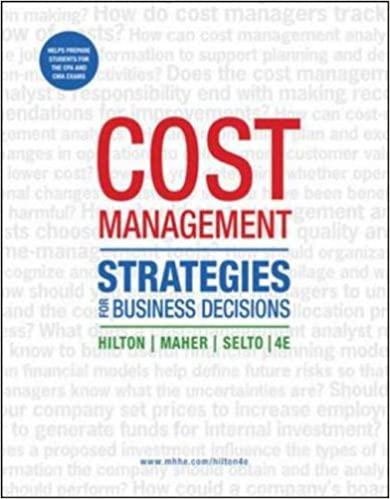Whelan Corporation makes bicycle frames in two processes, tube cutting and welding. The tube-cutting and welding processes
Question:
Whelan Corporation makes bicycle frames in two processes, tube cutting and welding. The tube-cutting and welding processes have a practical capacity of 150,000 and 100,000 units per year, respectively.
Committed costs of quality activities follow:
Design ofiproduet anc! prOCeSS'ICOSIS Eee canna rte: neo eee $220,000 INSOSCUOMAMG TESUINONCOSTS terres emeeenetees earn cette eae preenn anne eee 85,000 The demand is very strong. Whelan can sell all output it can produce at $180 per frame. It begins producing only 100,000 units in the tube-cutting department because of the capacity constraint on the welding process; any defective units it produces are scrapped. Of the 100,000 units started at the tube-cutting department, 1,000 units (1 percent) normally are scrapped. (Scrap is detected at the end of the tubecutting operation.) Full costs, based on total manufacturing costs incurred through the tube-cutting operation, equal $105 per unit:
Direct materials (variable Per UNIt) oo... cece ccc ee teeeeeetseseeeseees $ 88 Direct manufacturing, setup, and materials handling labor .......... it Manufacturing overhead (fixed for the year) oo... cceeceeeteeeees 10 aU CLOESIC TONSY AO Leese ice = ceA c pete ae gene teres coe aaeeeroeees inea ser snore cecanca te $105 The tube-cutting department sends its good units to the welding department. Unit-level manufacturing costs in the welding department are $43.50 per unit. Welders are very highly trained, and the welding department has no scrap. Therefore, Whelan’s total sales quantity equals the tube-cutting department’s output. Ray Whelan, the company president, has had his designers develop three alternative improvements to reduce scrap in the tube-cutting department.
Alternative 1: Leaving the process unchanged but starting enough units in the tube-cutting department so that the welding department can operate at practical capacity.
Alternative 2: Using a different type of tubing that is more resistant to damage and would reduce scrap by 80 percent. It would increase the unit-level costs per unit in the tube-cutting department by $10 but would reduce costs in the welding department by $5.
Alternative 3: Spending an additional amount on training to reduce scrap in the tube-cutting process.
Required Form small groups to respond to each of the following items:
a. Which alternative—1l or 2—is more attractive financially?
b. How much would the company be willing to spend on training and how much would scrap have to be reduced to make alternative 3 as attractive as either alternative 1 or 2?
c. What other qualitative factors should Whelan consider in making the decision?
Step by Step Answer:

Cost Management Strategies For Business Decisions
ISBN: 12
4th Edition
Authors: Ronald Hilton, Michael Maher, Frank Selto





